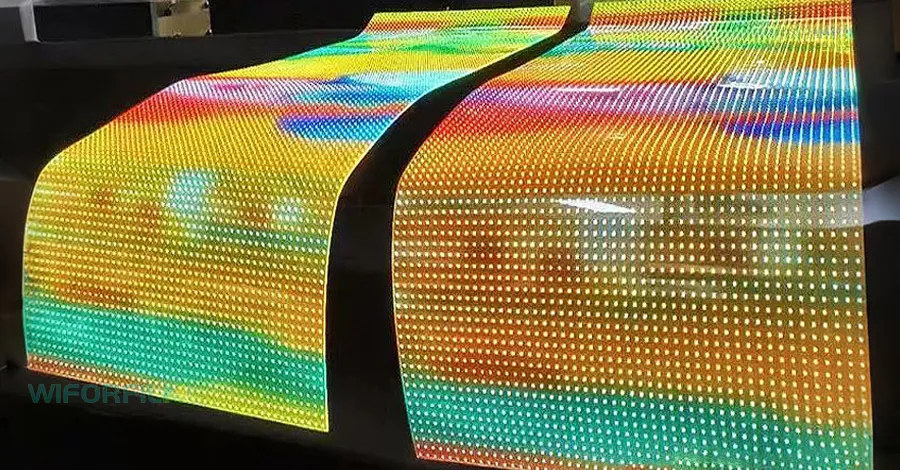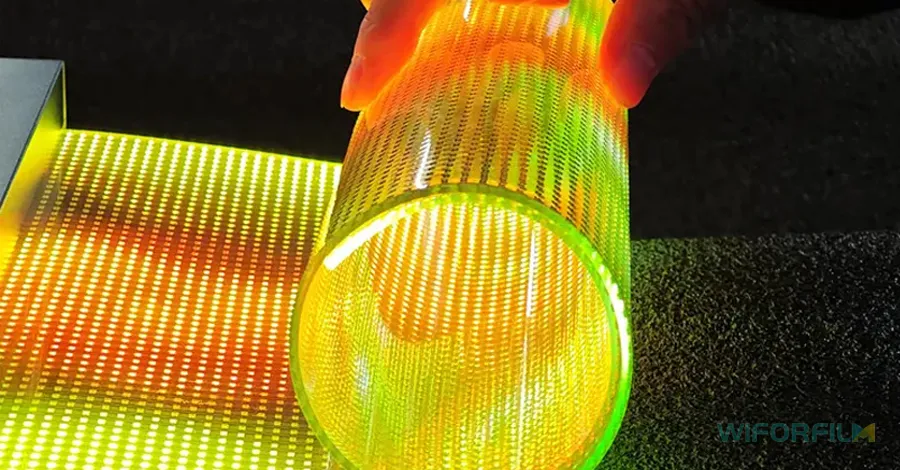LED Film Screen Definition
A LED film screen, also known as a transparent LED display film or flexible LED film, is a revolutionary display solution that combines advanced LED technology with ultra-thin transparent materials. It allows vivid visuals—videos, images, and animations—to appear directly on glass surfaces while maintaining excellent visibility and light transmission.
When turned off, the screen is almost invisible, blending seamlessly into glass facades, windows, or interior partitions. When powered on, it becomes a bright, dynamic display. Because of its transparency, flexibility, and lightweight design, the LED film screen has become an ideal choice for retail storefronts, commercial buildings, exhibitions, showrooms, and architectural media facades.
Unlike conventional LED panels, which are heavy and opaque, LED film screens are designed to be thin, flexible, self-adhesive, and easy to install—turning any glass surface into a high-impact digital display.
How Does a LED Film Screen Work?
The working principle of an LED film screen is straightforward yet innovative. Tiny LED chips are embedded on a transparent, flexible substrate made of PET or polymer film. These LEDs are arranged in an evenly spaced grid pattern that forms pixels capable of displaying full-color images and videos.
Each LED emits red, green, or blue light (RGB), and when controlled together through a digital system, they create bright, high-resolution visuals. The transparent film contains conductive lines that transmit power and data signals to each LED while still allowing 60–95% of natural light to pass through.
The film connects to a NovaStar controller, which manages color calibration, brightness, and image playback. This setup enables the film to function as a fully interactive and programmable display system—while keeping the glass clear when not in use.
Key Features of LED Film Screens
1. High Transparency
LED film screens maintain up to 95% transparency, ensuring that natural light and visibility are not compromised. This allows businesses to maintain open views, especially in retail windows or architectural glass facades.
2. Ultra-Thin & Lightweight
The entire film is only 1–3 mm thick and weighs less than 3 kg/m², making it one of the thinnest digital displays available. It can be applied directly onto glass without any metal frames or heavy structural support.
3. Wide Pixel Range (P5–P20)
LED film screens come in multiple pixel pitches—P5, P6, P8, P10, P15, and P20—to suit different applications. Smaller pitches (P5–P8) deliver higher resolution for indoor use, while larger pitches (P15–P20) are ideal for outdoor facades where viewers are farther away.
4. High Brightness & Clarity
With brightness levels ranging from 2,000 to 5,000 nits, LED film screens stay visible even under direct sunlight. They support 16-bit color depth and refresh rates up to 7,680 Hz, ensuring smooth and vibrant video playback.
5. Flexible, Cuttable Design
The transparent film can be bent or cut into custom shapes, fitting seamlessly onto curved glass, columns, or irregular surfaces. This design flexibility is key for creative installations and architectural integration.
6. Energy Efficiency
Compared to traditional LED panels, LED film screens consume up to 30% less energy, as only the LED nodes emit light and no heavy back panel or frame is needed.
7. Self-Adhesive Installation
Many models feature a built-in adhesive layer, allowing users to directly apply the film to glass. Installation is quick, clean, and frame-free—perfect for upgrading existing spaces without construction.
Main Applications of LED Film Screens
1. Retail Storefronts
LED film screens are transforming retail advertising. Installed directly on store windows, they display promotions, videos, and brand visuals without blocking the view of the interior, creating a futuristic shopping experience that draws attention day and night.
2. Commercial and Corporate Buildings
Office towers, hotels, and malls use LED films on glass walls, atriums, and lobbies to show digital art, corporate logos, or messages. The screens enhance the modern architectural look while serving as effective communication tools.
3. Exhibition Halls and Showrooms
In trade shows and car showrooms, LED film displays create immersive product presentations. Transparent films can wrap around glass partitions or display floating visuals that make products stand out dramatically.
4. Glass Curtain Walls and Balustrades
Architects increasingly integrate LED film into glass curtain walls, balustrades, and skylights, merging structural design with digital aesthetics. This combination adds visual appeal without altering the building’s transparency.
5. Transportation and Automotive Applications
Transparent LED films are also being used in airports, train stations, and automotive glass. They allow for real-time information displays, dynamic advertisements, and even smart windshield projections in concept vehicles.
6. Rental and Staging Events
For concerts, theater productions, and exhibitions, LED film screens serve as flexible stage backdrops. Their transparency allows lighting designers to combine live visuals with physical performance for stunning effects.
Advantages Over Traditional LED Displays
| Feature | Traditional LED Display | LED Film Screen |
|---|---|---|
| Structure | Bulky cabinets, metal frames | Frameless, film-based design |
| Transparency | Opaque, blocks light | Up to 95% see-through |
| Thickness | 50–100 mm | 1–3 mm |
| Weight | 20–30 kg/m² | 1–3 kg/m² |
| Installation | Requires steel structures | Self-adhesive, stick-on glass |
| Energy Use | High | 20–30% lower |
| Aesthetic | Visible screen body | Invisible when off |
| Maintenance | Requires disassembly | Easy module replacement |
| Flexibility | Rigid | Bendable and cuttable |
| Applications | Indoor/outdoor video walls | Glass facades, showrooms, architecture |
The LED film screen clearly outperforms traditional displays in appearance, efficiency, and versatility—making it the preferred choice for modern, space-saving digital signage.
Technical Specifications of LED Film Screens
| Specification | Typical Range |
|---|---|
| Pixel Pitch | P5–P20 |
| Transparency | 85%–95% |
| Brightness | 2,000–5,000 cd/m² |
| Color Depth | 16-bit |
| Refresh Rate | 3,840–7,680 Hz |
| Viewing Angle | 140°–160° |
| Thickness | 1–3 mm |
| Weight | 0.5–3.5 kg/m² |
| Working Temperature | –20 °C to +50 °C |
| Lifetime | 50,000–100,000 hours |
| Installation | Self-adhesive or framed |
| Power Efficiency | 20–30% less than standard LED panels |
Models with P5 or P6 pitch deliver high resolution for close-up visuals, while P15–P20 models are ideal for large outdoor displays or architectural facades.
Installation and Maintenance Guide
Installing an LED film screen is simple and efficient. Here’s a general step-by-step process:
Installation Steps
-
Clean the Surface
Wipe the glass clean to remove dust or oil. Ensure it’s completely dry and smooth. -
Align the Film Panels
Measure and position each LED film according to your layout plan. Align the edges accurately to ensure seamless visuals. -
Apply the Film
Peel off the protective layer and attach the film to the glass surface. Use a soft scraper to remove any air bubbles. -
Connect Power and Signal Cables
Connect the modules to the controller and power supply. Many systems use daisy-chain connections for simplicity. -
System Setup and Calibration
Use the control software to adjust brightness, color, and synchronization for optimal display performance.
Maintenance Tips
- Clean the film gently with a microfiber cloth—avoid alcohol or solvents.
- Replace defective LED strips individually instead of removing the entire screen.
- Regularly inspect cables and connectors to ensure stable power and data transmission.
With proper care, a LED film screen can operate reliably for 8–10 years or longer.

10 Frequently Asked Questions (FAQs)
1. What is the difference between LED film and LED glass?
LED film is a flexible, self-adhesive display that can be applied to existing glass, while LED glass integrates LEDs directly during the glass manufacturing process. LED film is more versatile and cost-effective.
2. Can LED film screens be used outdoors?
Yes, certain models with higher brightness and weatherproof coatings (IP65) are suitable for outdoor use on glass facades or shop windows.
3. Are LED film screens compatible with all glass types?
They can be installed on most smooth, non-porous glass surfaces, including tempered and laminated glass. Rough or textured glass is not recommended.
4. How transparent is a LED film display?
Depending on pixel pitch, transparency ranges from 70% to 95%, allowing natural light and outside views to remain visible.
5. Can I cut LED film to a custom shape?
Yes, LED films can be trimmed and shaped to fit curved or irregular surfaces, provided the cutting lines avoid the embedded circuit paths.
6. How is content managed on LED film screens?
They can be connected to a media controller or cloud-based system to manage videos, animations, and live content remotely.
7. Is it difficult to maintain a LED film screen?
Not at all. Since the film attaches to glass, individual sections can be replaced easily without removing the entire screen.
8. What is the lifespan of a LED film display?
A high-quality LED film screen lasts 50,000–100,000 hours, depending on usage and environmental conditions.
9. Does LED film affect indoor lighting or visibility?
No, the high transparency ensures natural light passes through, maintaining an open and bright indoor environment.
10. Which models are suitable for my project?
For indoor, close-range applications—choose P5 or P8.
For outdoor facades or long-distance viewing—select P10, P15, or P20.



Associated Products
You may also be interested in the following products:
Self-Adhesive Transparent LED Display Film - P5
Transparent LED Film Display Screen - P6.25
Flexible LED Transparent Film Screen - P8
Ultra Transparent Film LED Screen - P10
Transparent Flexible Film Screen - P15
LED Crystal Film Screen - P20